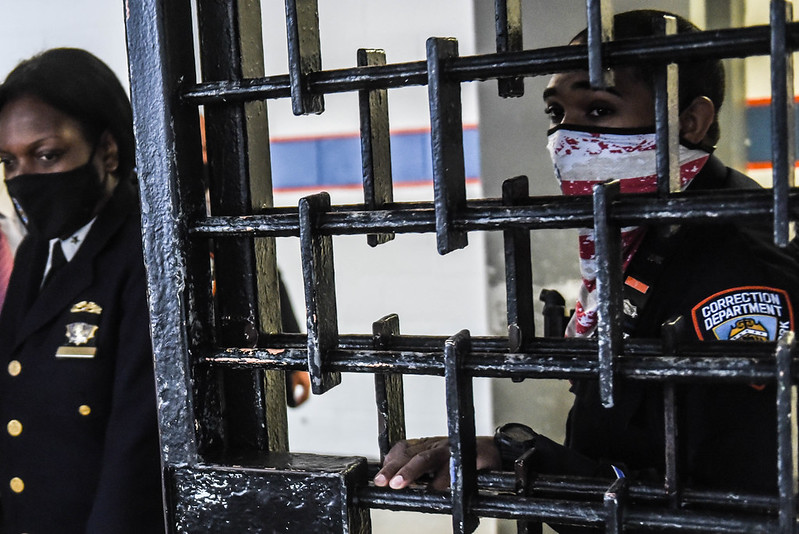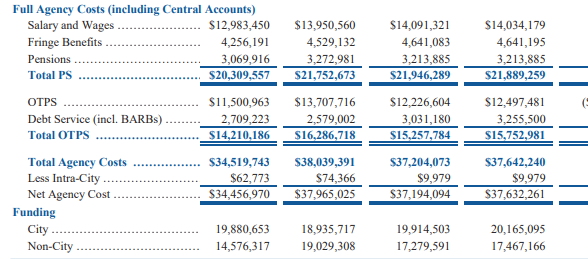To Address Our Mental Health Crisis, Close Rikers Now

Guards on Rikers Island (photo: Michael Appleton/Mayoral Photography Office)
Mayor Adams says we cannot look away from New Yorkers who are suffering. Yet, his new preliminary budget suggests that he’ll slash social services now and over the coming years. Yet, he continues to say ‘yes’ to luxury developers and dedicate limited resources to supportive housing. Yet, he questions the mandated closure of the Rikers Island jail complex.
New York City is required by law to close Rikers by 2027. The conditions at Rikers should prompt the administration to accelerate that timeline. Instead, our mayor is asking the City Council to extend it, or reconsider closing Rikers altogether. We don’t need Rikers. We need plans for more community-based supports, more crisis respite centers, more hospital beds for those who need emergency care, and more investments in a culturally competent and linguistically appropriate workforce.
People at Rikers – more than half of whom are affected by mental illness and almost 17% of whom have a serious mental health diagnosis – are far too often not receiving the treatment they need and are subjected to inhumane, unsafe conditions, including solitary confinement. They are not in the right place for the treatment they need. Rikers has been aptly described as a “torture chamber.”
New Yorkers at Rikers don’t have access to appropriate mental or medical health-care. They are already isolated in a place that takes their families hours to reach by public transportation, and soon may no longer have access to physical letters and other mail. Those who are incarcerated are still subjected to solitary confinement even though we passed the HALT Act and know that solitary confinement significantly increases the risk of suicide and self-harm. In 2022 alone, 19 of our fellow New Yorkers died at Rikers—many of them lost to suicide and preventable medical issues. Another 15 died in 2021.
Rikers is a death sentence.
What other reasons do we need to close Rikers? Why are we still debating this?
NAMI-NYC is a part of the Treatment Not Jails coalition, a group based on a bill with the same name. The Treatment, Not Jails Act would ensure that people living with serious mental illness are diverted from the criminal legal system and instead have access to therapeutic and trauma-informed care. Research shows that government saves money by investing in mental health and drug treatment courts, which both reduce recidivism.
We have also spoken with reporters, families, and many others about the mayor’s problematic forced hospitalization directive. If we closed Rikers and provided actual mental health care – more crisis response teams, more psychiatric hospital beds, more crisis centers, more peer-based community centers – we wouldn't be in this position. To live healthy lives, people need treatment, not jail stays.
We are tired of false promises. Rikers is under a costly federal monitor, but not improving and as an institution, it is beyond repair. It costs far more to jail New Yorkers than to provide the health-care services and supportive housing they need. The mayor must move more aggressively to close Rikers as quickly as possible. It's clear to NAMI-NYC and over 130 organizations signed on to the Campaign to Close Rikers that it’s the humane thing to do.
***
Matt Kudish is CEO of the National Alliance on Mental Illness of New York City (NAMI-NYC), helping families and individuals affected by mental illness for over 40 years. On Twitter @NAMINYCMetro.
***
Have an op-ed idea or submission for Gotham Gazette? Email This email address is being protected from spambots. You need JavaScript enabled to view it.
Honoring Norm Fruchter, A Leader with Profound Impact on New York’s School System

Norm Fruchter (photo: Courtesy of NYU Metro Center)
Norm Fruchter, an education activist whose unique intellectual and organizational abilities led to major change for the New York City school system, died in early January from injuries sustained after being hit by a car in December. His special significance was recognized in a New York Times obituary.
Norm’s contributions weren’t just about school funding, but the development of the small school movement that focused on equity and integration as well.
My early years of service in the New York State Assembly in the ‘80s and ‘90s overlapped with Norm’s service as an elected school board member in District 15 in Brooklyn, from 1983 to 1994. District 15 included the neighborhoods I represented, Park Slope, Windsor Terrace, Sunset Park, Kensington, and Boro Park, and I knew Norm well.
His leadership in organizing the Campaign for Fiscal Equity school funding lawsuit, brought in 1993, was affirmed by New York State Senator Robert Jackson, one of the original plaintiffs in the case, when I spoke with the Senator.
Senator Jackson, who was an elected School Board member from Washington Heights at the time, said that among Norm’s critical insights (along with Heather Lewis, another District 15 School Board member whom Norm married after his first wife when she was also hit by a care in 1997), was to ensure parents and their kids as plaintiffs. When the State moved to dismiss the case, the courts ruled that the City of New York and the community school board did not have standing to sue the State, but parents and their kids did, and the case was allowed to proceed.
One of my clearest memories of Norm involves a confrontation between him and then-Speaker of the Assembly Mel Miller about school funding at a District 15 School Board meeting in the late ‘80s. The powerful Brooklyn Speaker, whose own district also overlapped District 15 along with mine, had simply arrived at a local community meeting. I was in the audience when Norm began ‘speaking truth to power,’ criticizing unfair State funding of the City school system in comments directed at Miller.
Miller defended the State aid formula, which required the City to contribute to school funding in proportion to its own wealth. They argued and it was an unsettling public conversation. I see it now as a prelude to the CFE lawsuit, which argued that the issue was broader than just the distribution of aid, that in fact the amount of money for the schools was simply not adequate to provide a basic education.
It took ten years of resistance from former Governor George Pataki before the lawsuit was victorious in the State’s highest Court, the Court of Appeals. Even then, large sums of money to make good had to await the early budgets of Governor Eliot Spitzer. The premise of the lawsuit was not just that the State had obligations to increase funding, but municipalities too because they were subdivisions of the State.
The additional dollars in the New York City school budget are immense compared to decades ago, even adjusted for inflation (enrollment is similar), overcoming the 2008-2009 recession and the covid pandemic. Below is a snapshot of the New York City School Budget from 1999-2000, taken from the Department of Education’s School-Based Expenditure Report:

The City’s system-wide budget was $11.39 billion in that year and enrollment was 1.1 million students. Per pupil expenses were roughly $10,000 per year.
Fast forward to the 2022-2023 City schools budget (via New York City Office of Management and Budget, Publications 2022, Mayor’s Message, FY 2023 Executive Budget - Message of the Mayor (nyc.gov) :

The New York City education budget is now $37.2 billion; there are still about 1.1 million students.Inflation has doubled since 1999, meaning funding in today’s dollars has risen from $22.6 billion then to $37.2 billion now, a 67% increase per student after the inflation adjustment. (The City of New York remains the largest contributor, funding 54% of the budget, with the State and Federal governments the remainder.)
While there has been much significant change since the CFE lawsuit was brought in 1993, Robert Jackson, Norm Fruchter, Heather Lewis, and the many other activists who brought that lawsuit, with their lawyer Michael Rebell, surely laid a foundation for the system to have the resources it would require for progress in areas like graduation rates.
No tribute to Norm would not be complete without a mention of his contribution to the small schools and public school choice movement. I was also there when a small group of parents and teachers in District 15 founded the Brooklyn New School in 1989 (discussed in this Chalkbeat column on Norm’s passing). Norm described his involvement: “Fruchter recalled getting a pitch from a group of parents dissatisfied with the largely segregated local public school in their neighborhood and pushing to open a new one.”
“I shared the parents’ vision of a small school driven by progressive instruction, project-based learning and a parent choice lottery admission process designed to ensure a diverse and representative student population,” he later wrote, even though he had some misgivings about the idea of starting a new school. That push eventually led to the creation of Brooklyn New School, a progressive public elementary school that remains a popular choice in District 15.
The small schools movement gained momentum as the system’s failures deepened. A 1994 report from then-New York City Schools Chancellor Ramon Cortines acknowledged that the high school on-time graduation rate was 44%, and dropout rates were astonishingly high. Norm spurred grants from the Diamond Foundation to fund public school choice initiatives like innovative new schools, along with other groups like the Annenberg Institute and New Visions.
Elected New York City school boards were (unfortunately, in my view) abolished in 2002, along with the State Legislature granting new Mayor Michael Bloomberg administrative control of the school system. Bloomberg brought in one of Norm Fruchter’s friends, Michele Cahill from New Visions, to help develop new schools. The result was hundreds of new schools throughout the system, many connected to the breakup of the big high schools.
I’m not sure Norm would celebrate the charter schools now educating a large portion of city students, but his visionary contributions to the small schools movement is another one of his unique achievements. The 2022 on-time high school graduation rate for New York City school students was 77%, a far cry from 44% in 1994.
Norm Fruchter was a brilliant person who shined a light on the path forward for the New York City schools. His final blog, written shortly before he was killed, showed he was keeping up with the latest issues on the schools, criticizing Mayor Adams for limiting expansion of 3-K and advocating for his long-held principles and what he believed was best for New York City’s children.
***
Jim Brennan was a member of the New York State Assembly for 32 years, where he chaired four committees. On Twitter @JimBrennanNY.
***
Have an op-ed idea or submission for Gotham Gazette? Email This email address is being protected from spambots. You need JavaScript enabled to view it.
Fast-Tracking New York’s Transit Future
![]()
CM Brooks-Powers, left, with MTA CEO Lieber (photo: William Alatriste/NYC Council)
This week President Biden visited New York to celebrate a major milestone.
More than a decade after Superstorm Sandy badly damaged the century-old train tunnels between New Jersey and New York, we’re finally advancing the repair and expansion work needed.
New funding streams made possible by the Bipartisan Infrastructure Law are finally fast-tracking this essential project that will double the number of people able to move on trains beneath the Hudson River.
Federal funding for projects like this has historically been far too rare. Until recently, most federal transportation spending has overwhelmingly prioritized a narrow focus on expanding roads and highways. While these are important, the funding imbalance often neglected public transportation and the many millions of riders who rely on it.
This is beginning to change. The new law takes a bigger and broader view of what counts as infrastructure. This includes $89.9 billion in funding for public transit over the next five years; $7.5 billion to build out a national electric vehicle charging network; and $50 billion to make our infrastructure resilient.
As Chair of the New York City Council Committee on Transportation and Infrastructure, I'm especially excited about what's happening and determined to ensure we make the most of it. Here are three specific opportunity areas where increased federal funding can jump-start long-delayed transportation infrastructure work in New York City:
Fully accessible subways before 2055.
Much of our subway infrastructure was built a century ago, long before federal laws like the Americans with Disabilities Act were put on the books. Right now, approximately three out of every four subway stations are inaccessible to New Yorkers with disabilities, older adults, families with strollers, and many more who may need an elevator, ramp, or escalator. The MTA has a plan on the table to get 95% of our stations accessible by 2055. This isn’t soon enough! Dedicated federal funding can help us reach our goal sooner.
Significant street safety infrastructure for dangerous roadways.
Over the past year nearly half of all pedestrian fatalities occurred on the most dangerous 7% of streets in New York City. We’ve identified these “Vision Zero” priority corridors here in New York and targeted federal funding can accelerate our efforts to reach our goal of zero deaths on city streets.
In fact, on February 14 the City Council will hold a hearing dedicated to street safety infrastructure in New York City.
We know President Biden originally proposed $20 billion for a national “Street Safety For All” initiative which was whittled down to just $5 billion in the final infrastructure law. This is an area where we need to grow, not shrink our funding commitments.
Resilient transportation infrastructure everywhere.
In the face of climate change, we know we can’t wait for the next extreme weather event to hit before taking action. We know where streets flood during heavy rains and federal help is needed particularly in areas like Brookville Boulevard in Southeast Queens where overlapping city, state, and federal jurisdictions require every level of government at the table. The science tells us to prepare for a twenty-fold increase in seasonal coastal flooding in New York City and we need to be ready.
We look forward to welcoming the Biden Administration to New York again soon to build the transportation infrastructure New Yorkers need for the future!
***
City Council Member Selvena Brooks-Powers is Majority Whip and Chair of the Council’s Committee on Transportation and Infrastructure. On Twitter @CMBrooksPowers.
***
Have an op-ed idea or submission for Gotham Gazette? Email This email address is being protected from spambots. You need JavaScript enabled to view it.




